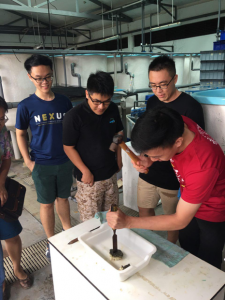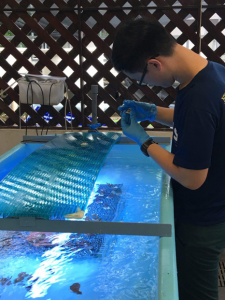
Marine Biology Workshop (Cnidarian Culture) at St. John’s Island
05 Jul 2017 - 06 Jul 2017
Event Navigation

On the 5 & 6 July 2017, two CAPTains were invited by Dr Toh Tai Chong for a Marine Biology Workshop held on St. John’s Island. The Cnidarian Culture Workshop was co-hosted by the St. John’s Island National Marine Laboratory (SJINML) and the National Museum of Marine Biology and Aquarium, Taiwan (NMMBA). The workshop sought to allow Singapore and Taiwanese counterparts to share knowledge and expertise on areas of marine biology, especially that of coral culturing and propagation. The CAPT students joined a vast group of participants (including local experts, local students and Taiwanese students) for day lectures by Singaporean researchers and their Taiwanese counterparts, and then for hands-on coral workshops in the marine laboratory.

During the lectures, the students were brought up to speed on SJINML’s recent work on rehabilitating the reefs around St. John’s Island. Especially insightful to them was the exposure to the work done by Taiwanese researchers, who were enthusiastic about sharing their experience not just with technical skills but also community engagement.
“We were inspired by the Taiwanese’s active collaboration with communities, such as coral reef enthusiasts, the wider public and other organisations. They even have begun working with the nuclear power plant situated close to the NMMBA! We feel that such mutually beneficial collaborations are essential in any project, and should be encouraged,” said Year 2 NUS Applied Mathematics major Tay Kai Yuan.
In the afternoons, the students engaged in hands-on work, and were allowed to take part in the process of propagating corals, which included physically cutting larger coral into smaller segments and attaching them to tiles so they would grow independently. The students also took to microscopes to study the physiology of coral and sea anemone up close.

Year 3 Environmental Studies major James Chang recounted the experience, “While I have heard about Singapore’s efforts in creating a marine sanctuary in the classroom, being able to see and experience the work first-hand made the theory come alive. The interactions with the instructors were also made more colourful as they were teaching and answering questions in their working environment. Many stories and anecdotes were prompted only by the fact that we were right in front of the creatures that they adored. This was especially special and unique to the fact that we were outside of the classroom.”
Perhaps the most encouraging aspect of the workshop for the students however, was seeing Singaporean and Taiwanese counterparts, both experts and students, share about life and academic experiences. In the end, the students left not only with a deeper understanding of marine life in Singapore’s waters but also the vast potential for cooperation and engagement in the goal of making our waters full of colour and life.
